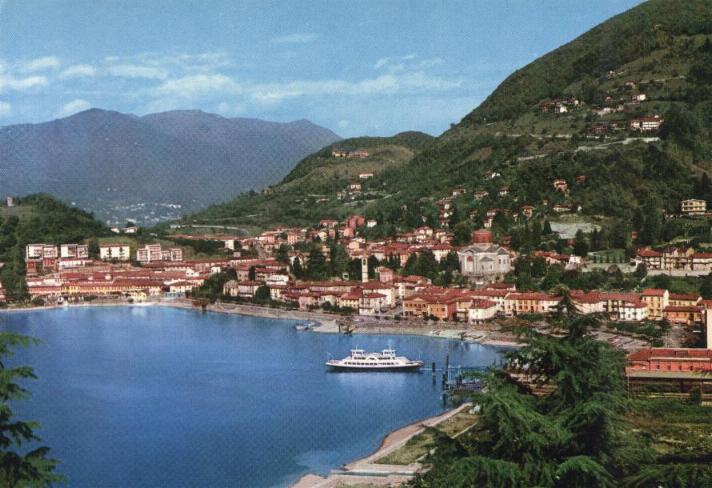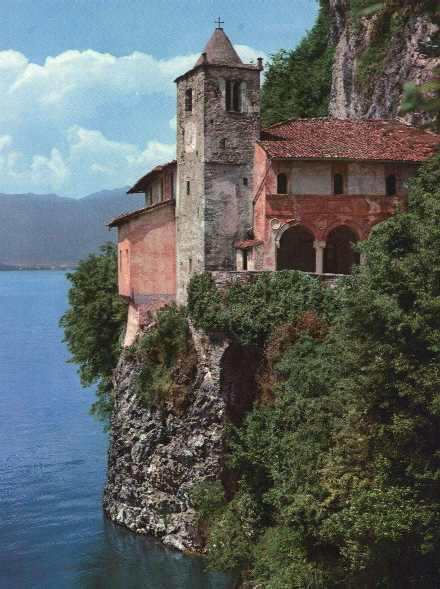|

Second day-trip Today 17/06/2000
We left Orta and at 10 am we arrived to Baveno a town on Lake Maggiore. Lake Maggiore despite its stately bearing, grand hotels and formal gardens, and its fringe of mountains, Maggiore is not highly rated by lake cognoscenti. The hotels are full of conference delegates; many of the gardens have something ineffably suburban about them; and the mountain fringe doesn't bear close inspection, since much of it has been eaten into by quarries.Worst of all, a main road hugs the shore for most of its length.
But there is a way of approaching the lake that unlocks itscharm. This is to move around its picturesque and busy central parts and southern reaches by boat, using the extensive network of ferries for short visits before retiring to its calmer shores.Maggiore is the largest of the pair of western lakes, separated from the much smaller Orta by the Mottarone, a scenic peak from which seven lakes can reputedly be seen on one of those legendary clear days. It extends from the tame, reed-fringed southern reaches, only half-an-hour's drive from Milan's Malpensa airport, up into the mountains of Switzerland. Around a third of the way up it widens, with a small gulf extending to the west around which the belle époque resorts of Stresa and Baveno and the more
down to earth Pallanza and intra, both fused with Suna by Mussolini in 1939 to form the municipality of
Verbania,are clustered. Although cliffs do not plunge spectacularly into the water as they do on Como, the mountains are a strong presence around Maggiore, especially snow-capped Monte Rosa, which, on another of those famous clear days, can be glimpsed from the eastern shore.At the center of the lake float the Borromean Islands: the Isola Bella, almost entirely occupied by the Borromeo family palace and gardens; the Isola dei Pescatori, its houses huddled together like survivors clinging to a raft; and finally (apart from tiny San Giovanni, which is not open to tourists), distant and aloof, the Isola Madre, another Borromeo fiefdom. At lunchtime, and again in the evening, tourists are ferried across to the Isola dei Pescatori for a characteristic (i.e. slapdash) meal, and are serenaded by characteristic (idem) accordionists who vie with each other to carry their melodies further and further away from eastern Piedmont . In the early morning, though, this really is the island of fishermen,they sit in front of their flat-bottomed boats mending nets, while their round-bottomed wives set out the shake-and-snow domes and the garish guides in four languages before kissing goodbye to their kids, who have to take the ferry to school over in Stresa.The only sensible way to experience all this is to stay on the island at the Hotel Verbano, one of two charming retreats on the central and southern reaches of the lake. The Verbano is a solid, ochre-colored building facing across to Isola Bella and the huge, unsteady-looking pile of the Borromeo Palace. Napoleon stayed in the latter; the Verbano, with its 12 peaceful, tastefully decorated rooms, does the rest of us very nicely.Lake Maggiore's smart , low-slung white ferries shuttle back and forth between Stresa and Isola dei Pescatori every half-hour in the summer, calling in at Isola Bella on the way. Here, visitors make a beéline for the Borromeo Palace.This is a stately triumph of the late Baroque, and its lakeside grottoes have a certain charm. But there is something stuffy about the gilded and mirrored rooms, adorned with the self-aggrandizing symbols of the Borromeos: three interlinked rings, a unicorn and, rather disturbingly, a mantrap. The gardens behind are as theatrical as they come, rising up in a series of terraces to a huge set piece, crowned by a prancing unicorn and bristling with obelisks, putti and
goddesses.Isola Madre is far more human.

|

|
|

|
|

Maggiore
Lake |
|


San Carlone

The
palace's roccocò rooms are more intimate than those on Isola Bella; one can see that this was where the family preferred to live. But it is the garden that is the glory of the
island; many will find it more impressive than the better-known Villa Tàranto on the
mainland, created by a retired Scots captain, Neil McEachern, which has some glorious
azaleas, bottlebrushes and water lilies, but seems too botany-by-numbers in its
approach. Isola Madre is more laid-back, and more playful,so that, for example, the arabica coffee plant grows next to a burst of sugar cane.The Borromeo family has a bit of a monopoly on sightseeing
here. They also own another of the lake's most popular attractions, the castle of Angera on the south-eastern
shore, and even those who want to drive to the peak of Mottarone from Stresa have to use the
Borromeo toll road. Appropriate really, as the family's most famous son, Saint Carlo
Borromeo, was a Counter Reformation éminence grise who made a career out of total control. The southern lakeside town of Arona has a huge bronze statue of him that provides one of
Maggiore's most bizarre tourist experiences: climbing up the stairs inside the statue to peer out at the lake through the eyes of a
saint.
|
|
|